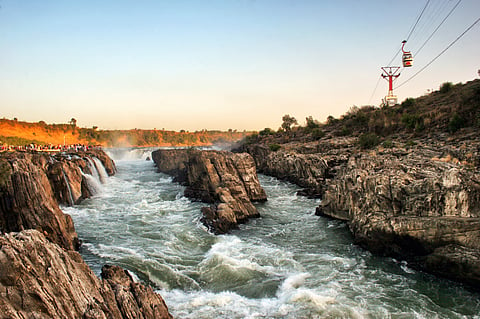
- Destinations
- Experiences
- Stay
- What's new
- Editor’s Picks
- Responsible Tourism
- CampaignsCampaigns
- Subscribe

One of the biggest cities in Madhya Pradesh, Jabalpur was an important centre of power during the rule of the Gond dynasty around the 15th century. It lies north of the Narmada River in a rocky basin surrounded by low hills that are dotted with lakes and temples. The city has a rich cultural and artistic lineage and has produced many writers and publishers who wrote their manuscripts in English, Hindi and Urdu. Today, it’s the gateway to renowned tiger reserves like Kanha National Park, Bandhavgarh National Park and Pench National Park.
Here then is your two-day guide to Jabalpur.
Start your day with a 19km drive to Bhedaghat to see the Marble Rocks. They form an 8km-long gorge along part of the Narmada River and soar to 30m on both sides. Its bright whiteness occasionally has pink, blue and azure veins running across it. The tall cliffs are made of magnesium limestone and watching the sun gleam on the white pinnacles is a breathtaking sight. There is a cable car to take visitors across the gorge, row boats for guided tours of the river downstream of the falls, and small shops filled with crafts made from local materials.
While you’re here, check out the spectacular sight of the Dhuandhar Falls. It falls from a height of 9m and cascades down with a roar even during the winter. Arguably, it is best enjoyed during the monsoons when the river is in full spate. The best viewpoint is from the three lookouts constructed just atop the falls. A ropeway to the falls has also been built. A short walk to the Ghughra Waterfall can also be considered.
In the same vicinity lies the Chausauth Yogini Temple. It is approached by a wide flight of steps formed from the remains that were here before the temple was built. The structure is circular and partially open to the sky, with shrines housing images of 81 yoginis and other deities. It was constructed by the Kalachuri king Yuvarajadeva II in the 10th century. Many of the stone yoginis have been defaced or left broken but there are plenty left intact for visitors to admire.
Head back to the city to see the Madan Mahal, also known as the Rani Durgavati Fort. This small fort dates back to the 11th century and was built by Gond rulers. The fort served its role as a military outpost with well-equipped rooms, stables and even secret passages for the royal family to enter into or escape from the building. There were stables for maintaining horses and housing for the army. The view from atop it provides sweeping and picturesque views of the surrounding landscape.
In the same area stands the Balancing Rock which you should see next. The big rock was created from volcanic rock formations and has withstood earthquakes with magnitudes of 6.5 on the Richter scale. The point of contact between the two rocks is only 6 square inches. As per the locals, nothing can disturb the equilibrium of these rocks. The area is surrounded by picturesque hillocks and makes for a lovely natural retreat for visitors.
Visit the Kachnar City Shiva Temple which has one of the tallest statues of the deity. The gigantic statue is 23m tall and sits on top of a cavern housing replicas of Shiva lingams or "Jyotirlingas." The 12 “Jyotirlingas” were collected from various shrines throughout the country. The evening aarti around 7PM is worth staying for but you can also explore the lush green surroundings and well-maintained premises of the temple as you wrap up your first day in Jabalpur.
Your final morning should begin with a trip to the Dumna Nature Reserve. Spread over nearly 728 hectares of forested land on a plateau, about 40m above Jabalpur, it is home to many species of native trees, plants, shrubs, herbs, creepers, climbers and grasses. The park boasts diverse ecosystems like woodlands, grasslands and wetlands. The place comes alive during the monsoon when the rains shower their blessings on the landscape. Count yourself lucky if you spot wild boars, crocodiles, leopards, chital, porcupines and butterflies during your time here. Visit the Khandari Dam where you can walk on a hanging bridge, stand on a fishing platform, ride a toy train and go boating on the rippling waters of the reservoir.
Visit the Nidan Falls to the north of Jabalpur next. The 30m-high waterfall is a beautiful sight to behold because of the way the rocks obstruct the water's flow due to their natural arrangement. Although it is excellent all year round, the monsoon season is the best time to see it owing to the splendid scenery.
Afterwards, visit the Bargi Hills and Sangram Sagar Lake area. The lake is the perfect weekend getaway for residents seeking an escape from the monotony of city life. Tourists can indulge in the fun of boating on its waters and admire the natural charm of the surrounding landscape where lots of migratory birds rest during their journey. Stroll along some of the nature trails in the area and reconnect with the more-than-human world.
Your final stop of the day should be Tilwara Ghat. It is the spot where Mahatma Gandhi’s ashes were immersed in the Narmada. The sacred ghat is a calm and serene place for those who seek a moment of peace by the riverside. The lush green surroundings and the gentle flow of the Narmada add to the tranquil atmosphere. Catch the last rays of the sun as it sets behind the horizon from here.
Land at Jabalpur Airport (JLR), also known as Dumna Airport, or the Jabalpur Junction Railway Station (JBP). There are buses and taxis to the city from Bhopal, Indore, Gwalior, Varanasi, Nagpur, Jaipur, Raipur, Prayagraj and Hyderabad, among others.
